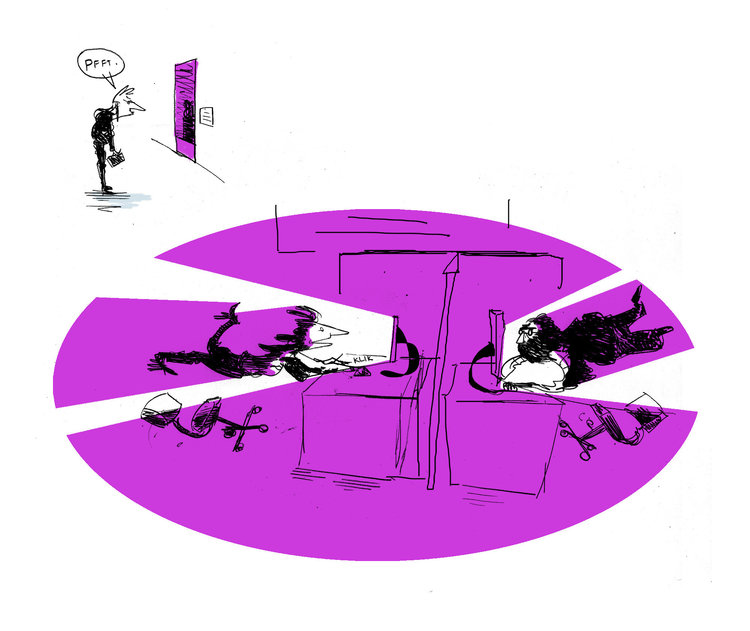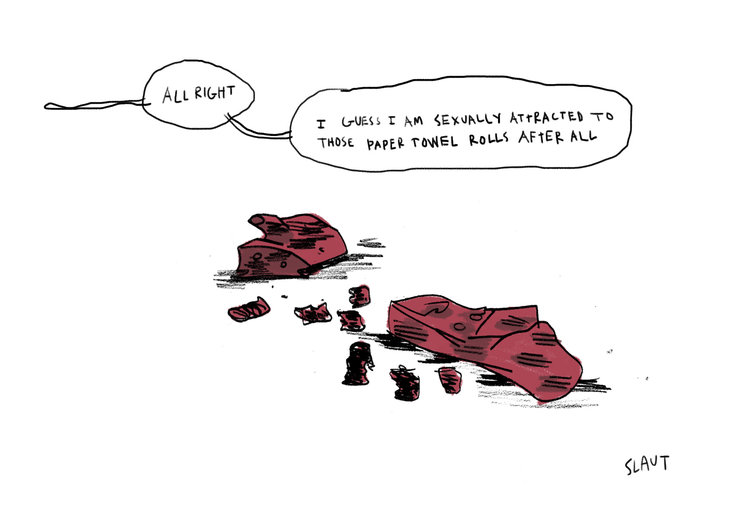Cartooning at the Whitney
Every two years, the Whitney Biennial is expected to provide a multi-perspectival impression of what artists in the United States are up to. This year, it couldn't do that.
Much of the art was created before the election. Six months ago things were tense, but most of us weren’t spending half of every morning on the phone with senators. This Biennial is saturated with politics, but you can tell that it was conceived before our November tragedy.
Ajay Kurian, Childermass (2017)
There were sixty-six artists in the show, and many more pieces. I drew as much as I could. I left out more than a few important, or beautiful, or notorious items: paintings by Henry Taylor, wood sculptures by Matt Browning, Cameron Rowland’s Social Impact Bond, Jordan Wolfson’s virtual reality Shehecheyanu superviolence thing, and a furniture/mirrors/ceiling and floor installation by Samara Golden whose wall text promised to “evoke anxiety” and, ouch. Three Dana Shutz paintings, one that got a lot of attention, two that got less.
This Biennial recap is drawings in pencil, colored digitally. I tried to write down the funny things we said. If we didn’t say anything worth plagiarizing, I drew a picture.
Kurian’s figures are dressed in clean Beefy T’s and mesh shorts. They’re zoomorphic, humanoid, cyborg things with C-3P0 prosthetics. Some have been scaled up, making them seem vulnerable instead of threatening, like Snuffleupagus. Most of them are about are the same size as I am, which really reinforces the scariness of the Whitney’s six-story stairwell drop.
Near the third floor there’s a sympathetic form in blue gym shorts and clean calf-length cotton socks. The waistband of his underpants is pulled up out of his shorts and over the top of his head. I thought this one would be easy to sketch, but the darkness I want to draw is so subtle—it’s the gallows humor of the angle at which he hangs, the large blankness in his face, the size of his hands, his cruelly pronounced victimhood. I write down a note: atomic wedgies—ALL redundant???
If someone in 1999 was invited to imagine a piece of installation art in 2017 they might sketch Evolution. An assemblage of screens, mannequins, props, and tchotchkes is spectacular and self-documenting—an analogy for what is expected of artists themselves.
Jon Kessler, Evolution (2016)
It feels good to find an illustrator. Celeste Dupuy-Spencer's work is the closest thing to cartooning we’ve seen in the exhibit yet, and this opens a tiny valve in our brains.
The paintings are good, they name names. I make the following mistake: I knew from my research that Dylann Roof, the Charleston shooter, would be in one of these paintings. He was Waldo. So where was he?
In the painting called Fall With Me For A Million Days (My Sweet Waterfall), I thought I saw Roof picking out a Jimi Hendrix song to listen to on iTunes, and organizing his Sam Cooke albums. But he wasn't in Fall With Me. He was where you'd expect him to be, in the Trump rally painting, looking plainly lost and ready to damage the world.
Tala Madani, Shitty Disco (2017)
Shitty Disco is one in a set of riffs on a archetypal, gendered metaphor: the human body filled with light. While Madani’s orifice paintings stick to a duality (front projections are smilier, and productive, rear projections are marked by the id) there’s an egalitarian quality to the images as a group. All the projections have a sensorial, energizing quality.
Sex Ed by God is an animation featuring God. Speaking in a grumpy voice, He recommends a hungry, fumbling perspective on human sexuality. He waits until the end of the lesson to hand down this commandment: “grab the clit and never let it go”. At the end of the film, God and a disciple are disappeared neatly into a floating vagina the size of a pistachio. I loved this and watched it twice.
Porpentine Charity Heartscape, With Those We Love Alive (2014)
This is a Twine game. Twine is open source software that anyone with internet can use to build nonlinear hypertext-based art.
You sit at a desk in a smallish cubicle and click through the story. The suggestion of privacy makes the difference between playing for two minutes and playing for ten. Absorption is key.
Heartscape loves words, and the words she chooses are wonderful—sticky, gothic, erotic. Between the sterile interface and decadent storytelling, there’s a particular tension.
One thing I’ve noticed in pastiche artwork from the past few years: a desire to pair something very, very old (like a medieval sigil) with something recently obsolete (like a Geocities website skin). Something the artist and her cohort have outgrown together, as a demographic.
Work by Kaari Upson
Kaari Upson’s soft sculpture made from upholstered furniture perplexed me but Katie liked it. “A matter of taste and orientation,” I said, not really knowing what was going on.
The wall text alluded to “erotic potential” in the sculptures. Their shapes are familiar but recombined, and colored like menstrual blood. Another factor was negative space. You move respectfully from one piece to the next, a little repulsed, a little into it.
Irena Haiduk (with jesus. d and David Sauters), Frauenbank (2017)
One of the more actionable pieces in the show, Frauenbank is a complicated nest: a thing with other things inside it. Connected to those things, systems, wealth, and data are further linked to events—all of this occurring elsewhere, far away, in outer space and Yugoslavia.
Locally, the installation is a mirrored tower, decorated with pieces of snake. Inside, a server.
The piece invites you to get online and invest in a womens’ (owned by and patronized by) banking co-op. Named in homage to a 1910 Berliner organization, the piece pulls in issues of decentralization, security, and takes direct advantage of newly legal boundaries around foreign investment in Serbian land.
Works by Raul de Nieves
Sara Lautman is a cartoonist, illustrator, and editor in Baltimore. Her work has appeared in The New Yorker, Playboy, The Believer Logger, Jezebel, The Pitchfork Review, Mad, The Awl, and The Comics Journal.












